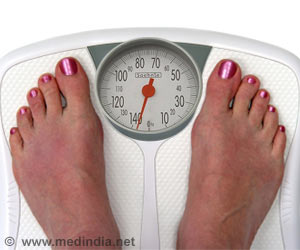Researchers at University of Michigan have uncovered a link between exposure to lead and increased risk of obesity.

"The data support the obesogen hypothesis that toxicant exposures in the womb contribute to the higher rate of obesity," said Dana Dolinoy, the John G. Searle Assistant Professor of Environmental Health Sciences and senior author of the study. "There are certain chemicals that are considered the hallmarks of the obesity epidemic, and lead has not been not one of them."
The closest previous research has come to tying lead exposure to weight are studies showing decreased fetal and early childhood growth in human infants, and obesity in later life in mice. But the U-M study is the first to look at how what a mother ingests, even before pregnancy, impacts her offspring. Scientists like Dolinoy and those in her lab have found that the crucial beginning of life often is where chemical exposure is most impactful.
The U-M paper, "Perinatal Lead (Pb) Exposure Results in Sex-Specific Effects on Food Intake, Fat, Weight and Insulin Response across the Murine Life-Course," is published in the current issue of PLOS-ONE.
In the study, mothers were exposed to lead through drinking water two weeks before mating then throughout pregnancy and nursing. Their litters were then measured at 3, 6 and 9 months of age for energy expenditure, spontaneous activity, food intake, and body weight and composition. At age 9 months they were tested for glucose tolerance. Researchers determined sex specific impacts on all of the measures.
The groups of mice were exposed to lead at 0.0 parts per million (ppm) for the control group, 2.1ppm, 16ppm or 32ppm. Maternal blood lead levels (BLL) tested at weaning were below the level of detection for the control group, 4.1 (±1.3) micrograms per deciliter (μg/dL), 25.1 (±7.3) μg/dL and 32.1 (±11.4) μg/dL, respectively.
Advertisement
The researchers found:Starting in early life, males in the two highest exposure groups outweighed the controls, a trend consistent from youth to adulthood. An increase in body fat at all dosages showed up in males at 3 months of age.Overall, both sexes exposed to the highest dose ate more than the control group, with males eating more at 6 months of age and female consumption increasing at 9 months of age.Exposed males showed impaired insulin levels at 9 months of age.Although females appeared more active for a time, there was no significant increase in spontaneous activity for either sex.In terms of energy expenditure, both sexes showed the expected decline in oxygen consumption and carbon dioxide production as they aged, but the exposed females had higher energy expenditure at 3 months of age and the exposed males had lower energy expenditure at 9 months of age.
Advertisement
Researchers used the wide range of exposure levels to more closely match with human experience. Baby boomers and other older adults once were exposed to levels much higher, on average, before some of the bans on lead. For example, in 1978 when lead was banned in U.S. paint, the national average BLL was 15 μg/dL, and the CDC "level of concern" was 30 μg/dL. The levels of exposure today are closer to the lower dosage the team used.
Lead author Christopher Faulk, research fellow in the Dolinoy Lab-Environmental Epigenetics and Nutrition, said prior to the study he did not fully appreciate the dangers of the exposure most of us have to lead.
"To see that the level I and others have considered very low has such statistical significance in this study is alarming. There is no minimum safe level for lead. Our research really supports this," he said.
Source-Eurekalert














